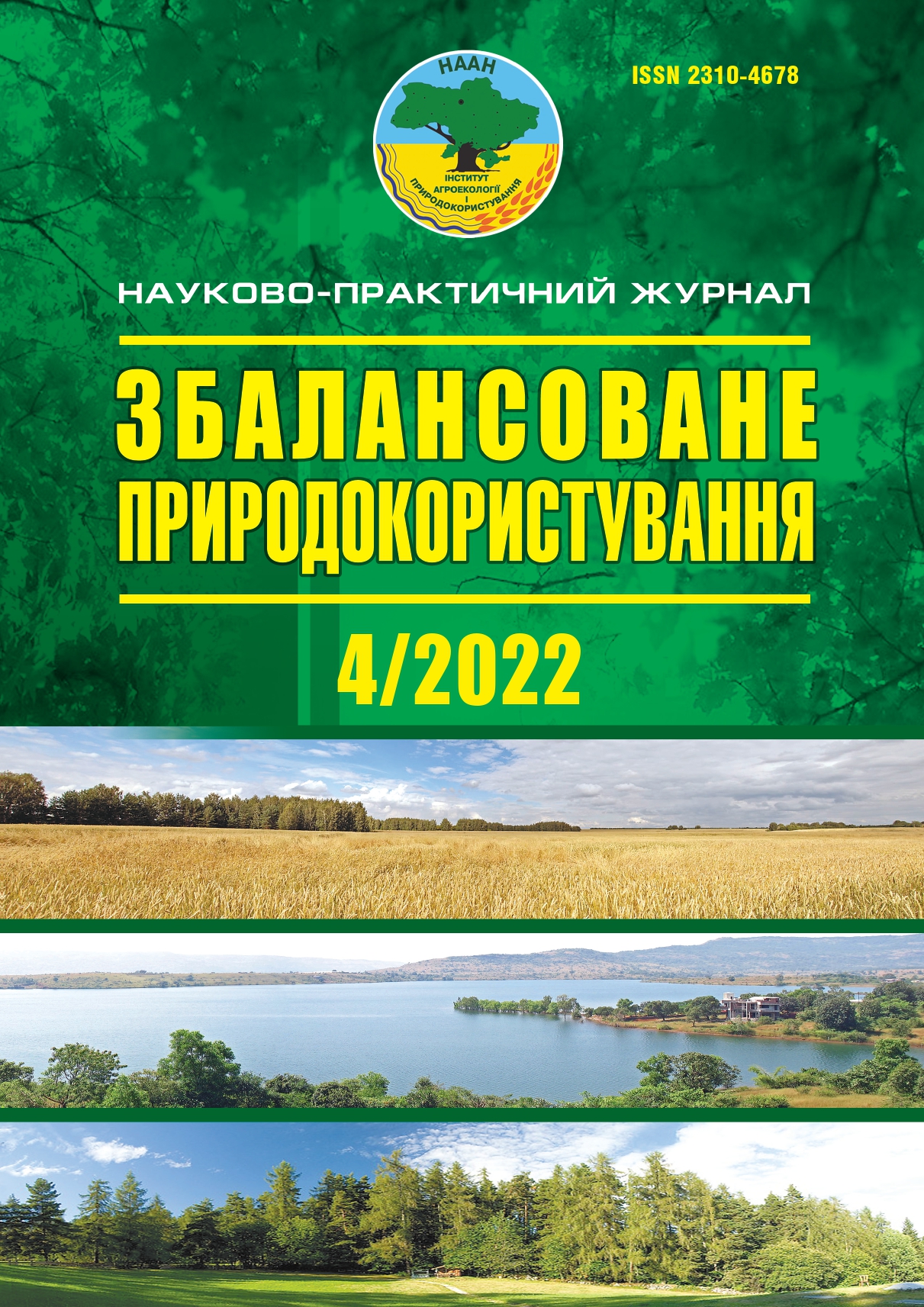The role of magnesium ions for the growth and development of tomatoes when growing in protected soil conditions
DOI:
https://doi.org/10.33730/2310-4678.4.2022.275039Keywords:
greenhouse, hydroponics, nutrient solution, chlorophyll, chlorosis, photoelectrocolorimetryAbstract
Tomato is one of the main and popular vegetable crops not only in Ukraine, but throughout the world. According to the Food and Agricultural Organization (FAO), tomatoes occupy the first place in the world in terms of cultivated areas among all vegetables — more than 4 million hectares. In Ukraine, about 93,000 hectares — about 24% of the total area under vegetables — are devoted to this culture. With the advent of high-intensity technologies with the use of drip irrigation systems, tomato yields of 120–140 t/ha in open ground, and more than 50 kg/m2 in sheltered ground, became real. Nowadays, the method of small-volume hydroponics with the use of drip irrigation is becoming more and more widespread in greenhouse farms. As a substrate, special materials are used — mineral wool, coconut, peat, etc. The selected substrate functions as a medium for the roots, feeding is carried out by supplying a fertilizer solution. When growing on a substrate, it is necessary to dose fertilizers very accurately and provide plants with a sufficient amount of nutrients. The paper investigates the effect of the concentration of the macroelement magnesium in the mineral wool substrate on the growth and development of the Campari (cocktail) tomato culture in protected soil conditions. It was established that the photoelectrocolorimetric method for determining the magnesium content in mineral wool hoods is quite sensitive, simple, and recommended for use in serial analyses. The determined content of magnesium salts (72.0 mg/l) turned out to be insufficient for growing tomatoes in the period of mass fruiting. Controlling the magnesium content allows you to significantly prevent tomato chlorosis and obtain high-quality crops.
References
Brezhnev, D.D. (1964). Tomatу [Tomatoes]. 2 edition. L.: Kolos [in Russian].
Ali, M.Y., Sina, A.A.I., Khandker, S.S., Neesa, L., Tanvir, E.M., Kabir, A. & Gan, S.H. (2021). Nutritional Composition and Bioactive Compounds in Tomatoes and Their Impact on Human Health and Disease: A Review. Foods, 10 (1), 45 [in English].
Vуrodova, A.P., Yanovchik, O.E. (2009). Okraska plodov tomata opredelyaet ikh biologicheskuyu tsennost [The color of tomato fruits determines their biological value]. Kartofel i ovoshchi — Potatoes and vegetables, 2, 30 [in Russian].
Kolupaev, Yu.Ye., Karpets, Yu.V. (2010). Formirovanie adaptivnykh reaktsiy rasteniy na deystvie K 61 abioticheskikh stressorov [Formation of adaptive responses of plants to the action of K 61 abiotic stressors]. K: Osnova [in Russian].
Alekhina, N.D., Yermakov, I.P. (Ed.). (2005). Fiziologiya rasteniy: uchebnik dlya studentov VUZov [Plant Physiology: textbook for university students]. M.: Izdatelskiy tsentr “Akademiya” [in Russian].
Belikov, P.S., Dmytrieva, G.A. (2002). Fiziologiya rasteniy: uchebnoe posobie [Plant Physiology: textbook]. M.: Izd-vo RUDN [in Russian].
Kapusta, L.S. (2006). Pomidory dlia tryvaloho zberihannia [Tomatoes for long-term storage]. Dim, sad, horod — House, garden, vegetable garden, 3, 12 [in Ukrainian].
Yanchuk, A.S. (2010). Vуrashchivanie tomatov v otkrуtom grunte dlya potrebleniya v svezhem vyde [Growing tomatoes outdoors for fresh consumption]. Ovoshchevodstvo — Vegetable growing, 4, 45–47 [in Russian].
Kravchenko, V.A. (2007). Obshchie podkhodу k tekhnologii vуrashchyvaniya tomatov v uslovyiakh zashchishchennogo grunta [General approaches to the technology of growing tomatoes in greenhouse conditions]. Ovoshchevodstvo — Vegetable growing, 10, 58–59 [in Russian].
Korogod, S.A. (2010). Bezrazsadnуi sposob vуrashchyvaniya tomatov [The seedless way to grow tomatoes]. Ogorodnik — Gardener, 4, 14–15 [in Russian].
Bуkhanova, K.E. (2001). Rannespelуe sorta pomidorov [Еarly ripe varieties of tomatoes]. Kartofel i ovoshchi — Potatoes and vegetables, 3, 40–41 [in Russian].
Miroshnichenko, E.V. (2010). Skorospelуy pomidor [Еarly ripening tomatо]. Ovoshchi i fruktу — Vegetables and fruits, 10, 56 [in Russian].
Morozova, L. (2021). Control of potassium concentration in fertilizing tomatoes in protected soil. Sciences of Europe, 64 (3), 21–26 [in English].
Morozova, L. (2021). The role of calcium ions in the prevention of riding mold of tomatoes in protected soil. Sciences of Europe, 66 (2), 12–17 [in English].
Likhochvor, V., Demchishin, A. (2016). Rol kaltsiya i magniya pri intensivnom zemledelii [The role of calcium and magnesium in intensive farming]. Propozytsiia — Offer, 1. URL: https://propozitsiya.com/rol-kalciya-i-magniya-pri-intensivnom-zemledelii [in Russian].
Karnaukhov, O.I., Melnychuk, D.O., Chebotko, K.O. & Kopilevych, V.A. (2001). Zahalna ta bioneorhanichna khimiia [General and bioinorganic chemistry]. K.: Feniks [in Ukrainian].
Gil, L.S. Pashkovskiy, A.Y. & Sulima, L.T. (2012). Sovremennoe ovoshchevodstvo zakrуtogo i otkrуtogo grunta. Prakticheskoe rukovodstvo [Modern vegetable growing of closed and open ground. Practical guide]. Zhytomyr: Ruta [in Russian].
Aliev, Е.A. (1985). Vуrashchivanie ovoshchey v gidroponnуkh teplitsakh [Growing vegetables in hydroponic greenhouses]. 2nd edition, supplemented and revised. Kyev: Urozhai [in Russian].
Naydun, S.N., Yurin, V.M. (2004). Mineralnoe pitanie rasteniy. Metodicheskie rekomendatsii k laboratornуm zanyatiyam, zadaniya dlya samostoyatelnoy rabotу i kontrolya znaniy studentov [Mineral nutrition of plants. Guidelines for laboratory classes, assignments for independent work and control of students’ knowledge]. M.: BHU [in Russian].
Downloads
Published
Issue
Section
License
- The authors reserve the right to authorship their work and pass the journal the right to publish this work under a Creative Commons Attribution License license, which allows other persons to freely distribute the published work with the obligatory The authors of the original work and the first publication of this magazine.
- The authors have the right to make independent additional agreements on the nonexclusive dissemination of the work in the form in which it was published by this magazine (for example, to post work in the company's electronic storage or to publish as a monograph) , subject to the first publication of the link to this journal.
- Journal policy allows and encourages the placement of authors on the Internet (for example, in the repositories of institutions or on personal websites) manuscript work as to the presentation of this manuscript to the editorial board and during its editorial processing, as it contributes to The productive scientific discussion and positively affects the efficiency and dynamics of citation published work (see The Effect of Open Access).


